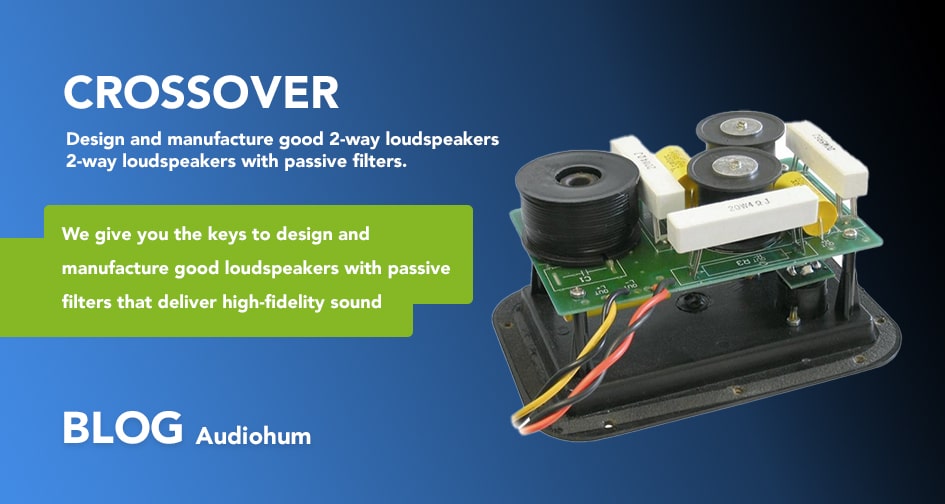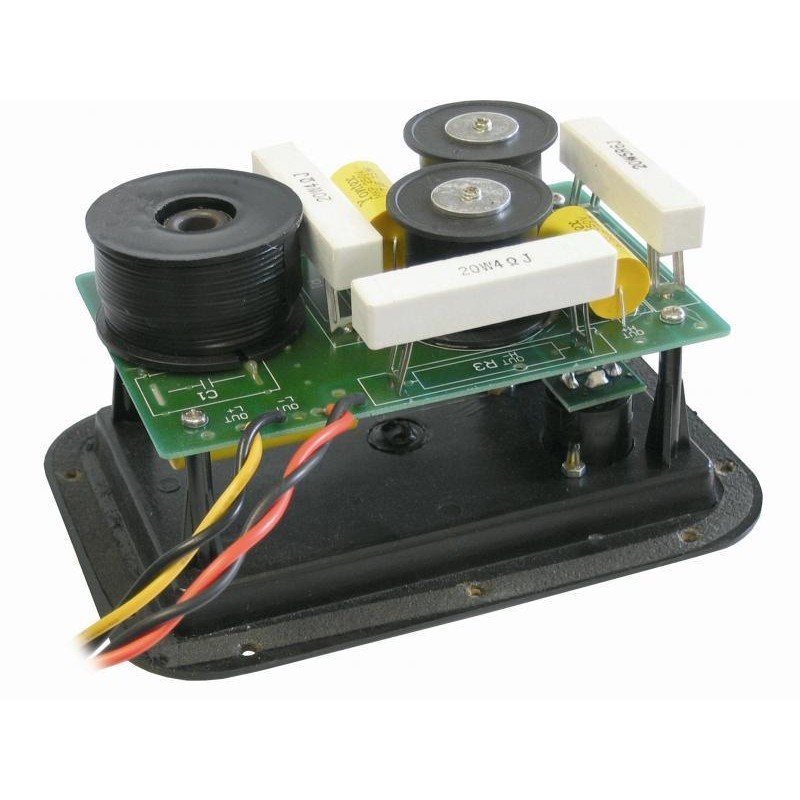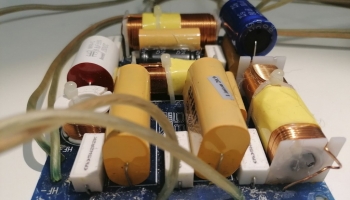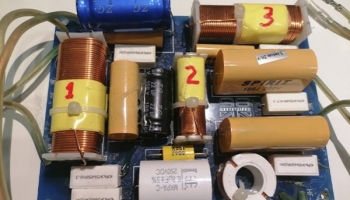Build your own two-way loudspeaker with passive filters

![]()
If you are a lover of hi-fi sound and are passionate about electronics and building your own devices, we give you the keys to designing and building good passive-filtered loudspeakers that deliver hi-fi performance.
Steps to follow to build two-way loudspeakers with passive filters
We will then guide you through the steps necessary to create your own two-way loudspeaker, a classic design that is widely used in high-quality audio systems. You will learn about the key components, such as drivers, passive filters and how to assemble them properly for a balanced and accurate sound.
1. Speaker selection.
To achieve linear frequency response and good sound dispersion, it is important to select high quality speakers that are designed to work together. You should consider the size and sensitivity of the loudspeakers, as well as the impedance and power rating.
Selecting the right drivers to build high-fidelity two-way loudspeakers is essential to achieve a linear frequency response and good sound dispersion. To make a proper selection, we advise you to follow the recommendations below:
Identify the application: It is important to identify the specific application for the hi-fi two-way loudspeakers, such as whether they will be for home music listening, home cinema or recording studios. The choice of transducer will depend on the application and the type of sound desired.
Selecting the speaker size: The size of the speaker affects the frequency response, sensitivity and power handling capability. For a two-way hi-fi loudspeaker, a size should be chosen that suits the intended application and allows for a flat frequency response and good sound dispersion. The most common sizes for two-way speakers are 5.25 inches, 6.5 inches and 8 inches.
Consider sensitivity: The sensitivity of the loudspeaker is an important factor to consider. Sensitivity refers to the amount of sound a speaker can produce from a given amount of input power.
Look for a linear frequency response: Frequency response refers to the speaker's ability to reproduce different frequencies of sound. It is important to choose speakers with a linear frequency response for high fidelity sound reproduction. It is generally considered that the frequency response should be within +/- 3 dB in the frequency range you wish to cover.
Consider impedance: Impedance refers to the electrical resistance of the loudspeaker to current flowing through it. It is recommended to choose loudspeakers with an impedance of 4 or 8 ohms for best compatibility with amplifiers.
2. Crossover design.
The crossover filter is a critical part of loudspeaker design. The filter must be designed to allow the loudspeakers to work together effectively, dividing the audio signal into frequencies suitable for each loudspeaker. It is important to note that the choice of filter components (capacitors, inductors and resistors) can significantly affect the performance of the loudspeakers.
Designing a crossover filter for two-way speakers is a task that requires engineering knowledge and experience in audio system design.
![]()

![]()
The basic steps to follow when designing a passive filter are as follows:
2.1. Consider the loudspeakers you have chosen, especially regarding the tweeter: The most common dome tweeters have a diameter of 20mm, 25mm or 28mm. If you use a 20mm tweeter you will have to be careful with the crossover frequency and slope you use, as a low frequency and/or a crossover slope of less than 12db could damage the tweeter.
2.2. Determining the crossover frequency: The crossover frequency is the frequency at which the audio signal will be split into two parts to be sent to the corresponding transducers. For a two-way loudspeaker, this means splitting the signal between the tweeter and the woofer. The ideal crossover frequency depends on the specific drivers you are using, but a good rule of thumb is to choose a crossover frequency between 2500 and 6000 hz, depending on the type of tweeter you are using and the filter slope.
2.3. Calculate the filter component values: Once the crossover frequency is known, the filter component values can be calculated. A typical second order crossover filter will include an inductor and a capacitor for each transducer. Resistance may also be needed to adjust the filter response. The exact component values depend on the impedance of the transducers and the chosen crossover frequency.
2.4. Test the filter: Once the values of the filter components have been calculated, it is important to test the filter to ensure that it is functioning properly. This can be done by measuring the frequency response of the loudspeaker and adjusting the filter components as necessary to achieve a smooth, linear frequency response. It is also important to ensure that the volume and power levels of the drivers are balanced.
It is important to note that designing a crossover filter for two-way loudspeakers is a complex task and that results may vary depending on the drivers and other system-specific factors. Therefore, it is advisable to work with an audio engineer or an experienced loudspeaker system design professional to achieve the best possible results.
If you need customised advice on designing and manufacturing your passive filter, please contact our customer service team so we can help you.
3. Cabinet design.
The design of the cabinet can have a major impact on the quality of the sound produced by the loudspeakers. The cabinet should be designed to minimise resonances and unwanted vibrations, and to ensure a flat frequency response. To do this, you must consider the size and shape of the enclosure, as well as the materials used in its construction.
Cabinets are an important part of hi-fi loudspeaker design. There are several types of enclosures, but two of the most common are enclosures and bass-reflex enclosures. We explain the characteristics of each.
Closed cabinets:
Closed cabinets are the simplest and most common. The loudspeaker is mounted in a sealed enclosure and has no other air outlet. The sound produced by the loudspeaker is emitted from the front and rear of the diaphragm. The air trapped inside the enclosure acts as a spring that opposes the movement of the speaker and provides precise control of the cone movement. However, the enclosure has limitations in the amount of bass it can reproduce. Therefore, closed cabinets are generally used for midrange and treble speakers.
Bass-reflex cabinets:
A bass-reflex enclosure is a closed enclosure with a tuned tube in its front or rear panel. This tube, known as a port, has a specific length and diameter that is tuned to allow air resonance at a specific frequency. The sound emitted from the rear of the speaker cone exiting the port reinforces the bass response of the speaker and provides an increase in efficiency in that frequency band. The main advantage of the bass-reflex enclosure is that a greater bass extension can be obtained from a smaller sized loudspeaker compared to a closed enclosure. In addition, a bass-reflex enclosure can be designed to provide higher power efficiency than a closed enclosure.
In summary, closed cabinets are suitable for midrange and treble speakers, while bass-reflex cabinets are more suitable for bass speakers. Both types of enclosures have their advantages and disadvantages, and the choice will depend on the specific objectives of each loudspeaker design. A well-chosen and properly constructed enclosure design can significantly improve the quality of the sound produced by the loudspeakers.![]()
These are the keys to design and manufacture good hi-fi loudspeakers with passive filters. If you need personalised advice, please do not hesitate to contact our team so that we can help you.
You can do so by clicking here.


